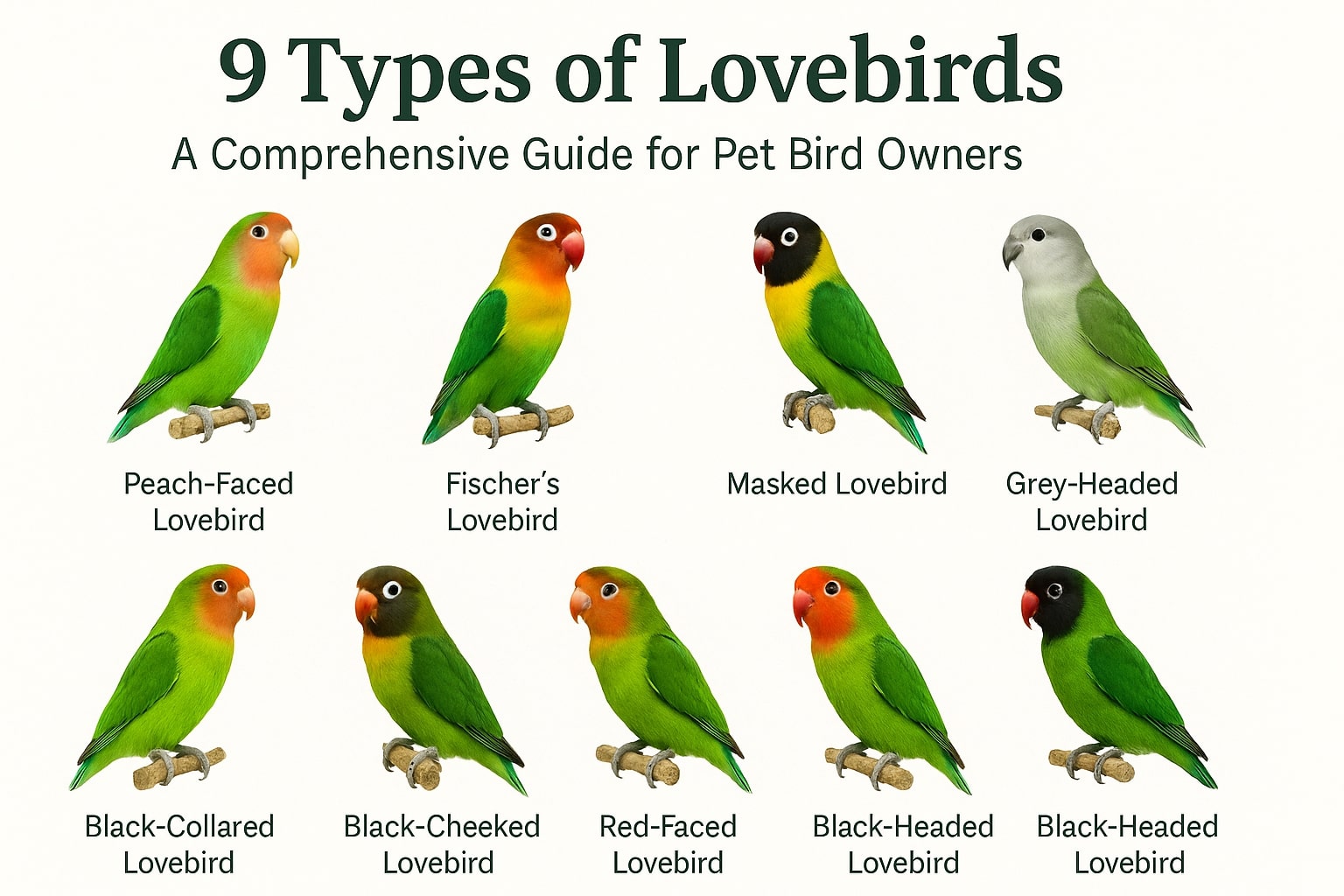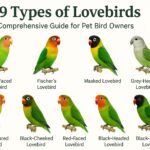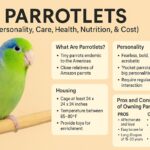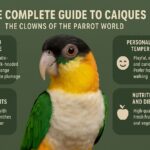Lovebirds are among the most cherished pet birds worldwide, known for their vibrant colors, playful personalities, and strong pair bonds. If you are a pet bird owner or considering bringing one of these charming parrots into your home, understanding the different types of lovebirds is essential for choosing the right companion.
This guide explores all nine recognized species of lovebirds, including their origins, physical features, temperament, and care needs, drawing from trusted sources in aviculture and ornithology.
The Nine Species of Lovebirds
There are nine recognized species of lovebirds, each with its own unique appearance, temperament, and care considerations. While only a few are commonly kept as pets, all nine are fascinating in their own right. Here is an overview of each species, with a focus on what pet owners need to know.
1. Peach-Faced Lovebird (Agapornis roseicollis)
Overview
The Peach-Faced Lovebird is the most popular and widely kept species among pet owners. Native to the arid regions of southwestern Africa, this lovebird is instantly recognizable by its bright green body and the warm peach or rosy hue that covers its face and upper chest.
Physical Characteristics
- Size: 6.5–7 inches (17–18 cm)
- Coloration: Wild-type birds have a green body, blue rump, and a peach or pink face. Selective breeding has resulted in many color mutations, including Lutino (yellow), Pied, and Albino varieties3.
- Lifespan: 12–14 years, sometimes longer with excellent care.
Temperament
Peach-faced lovebirds are energetic, fearless, and highly social. They enjoy interactive play, climbing, and exploring their environment. These birds can form deep attachments to their owners and may become territorial if not properly socialized.
Care Considerations
- Best for: Owners who want an outgoing, playful companion and are willing to provide daily interaction and mental stimulation.
- Special notes: They can be kept singly if given ample attention, but many thrive in pairs.
2. Fischer’s Lovebird (Agapornis fischeri)
Overview
Fischer’s Lovebird is another favorite among bird enthusiasts, known for its striking coloration and lively personality. This species is native to a small region around Lake Victoria in northern Tanzania.
Physical Characteristics
- Size: 5.5 inches (14 cm)
- Coloration: Bright green body, yellow-orange chest, blue lower back and rump, and a red beak. The face and upper chest often display shades of orange and yellow.
- Lifespan: 18–20 years with good care.
Temperament
Fischer’s Lovebirds are energetic, curious, and affectionate. They require plenty of stimulation and do best when kept in pairs or with regular human interaction. These birds are less aggressive than Peach-Faced Lovebirds, making them a good choice for families.
Care Considerations
- Best for: Owners seeking a playful, affectionate bird that enjoys both companionship and independent play.
- Special notes: They are known for their strong pair bonds and may become lonely if kept alone for long periods.
3. Masked Lovebird (Agapornis personatus)
Overview
Also known as the Yellow-Collared Lovebird, the Masked Lovebird stands out for its dramatic facial markings. It is native to northeast Tanzania and is one of the three most popular species in aviculture.
Physical Characteristics
- Size: 5.5 inches (14 cm)
- Coloration: Green body, bright yellow collar, black face mask, blue lower back and tail, and a red beak. The white ring around the eyes is a key identifying feature.
- Lifespan: 10–15 years.
Temperament
Masked Lovebirds are intelligent and can be a bit more reserved than other species. With patience and regular handling, they become affectionate and loyal companions. They are also known for their problem-solving skills and can learn tricks with consistent training.
Care Considerations
- Best for: Owners who appreciate a quieter, more contemplative bird and are willing to spend time building trust.
- Special notes: They may take longer to bond with humans compared to Peach-Faced or Fischer’s Lovebirds.
4. Lilian’s Lovebird (Agapornis lilianae)
Overview
Lilian’s Lovebird, also called the Nyasa Lovebird, is native to Malawi and parts of Mozambique, Tanzania, and Zambia. It is one of the rarer species in aviculture and is sometimes confused with Fischer’s Lovebird due to similar size and coloration.
Physical Characteristics
- Size: 5 inches (13 cm)
- Coloration: Mostly green body, orange head, red beak, and a white eye ring. The orange coloration is less intense than that of Fischer’s Lovebird.
- Lifespan: 10–15 years.
Temperament
Lilian’s Lovebirds are active, social, and thrive in small groups or pairs. They are less aggressive than some other species and can be kept with other peaceful birds if given enough space.
Care Considerations
- Best for: Experienced bird owners or those interested in keeping a small flock.
- Special notes: They are considered near-threatened in the wild due to habitat loss, so sourcing from reputable breeders is important.
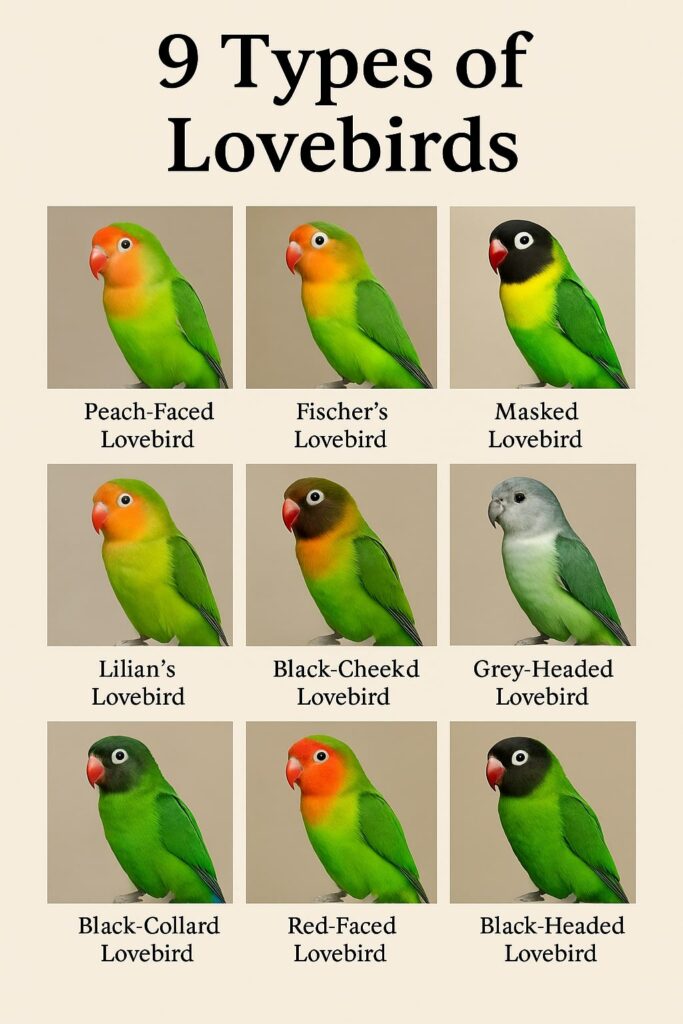
5. Black-Cheeked Lovebird (Agapornis nigrigenis)
Overview
The Black-Cheeked Lovebird is native to a limited range in southwestern Zambia and is considered vulnerable in the wild. It is named for the distinctive dark patches on its cheeks and throat.
Physical Characteristics
- Size: 5.5 inches (14 cm)
- Coloration: Green body, brownish-black cheeks and throat, reddish-brown forehead, orange upper chest, red beak, and a white eye ring.
- Lifespan: Up to 13 years.
Temperament
These lovebirds are calm, quiet, and less aggressive than some other species. They are peaceful and generally prefer quiet environments, making them suitable for smaller households or those seeking a less vocal companion.
Care Considerations
- Best for: Owners who want a gentle, quiet bird and can provide a calm environment.
- Special notes: Their population is declining in the wild, so always source from ethical breeders.
6. Grey-Headed Lovebird (Agapornis canus)
Overview
The Grey-Headed Lovebird is native to Madagascar and is the only lovebird species found outside mainland Africa. This bird is less common in the pet trade but is admired for its subtle beauty and gentle nature.
Physical Characteristics
- Size: Approximately 5.5 inches (14 cm)
- Coloration: Unlike the bright greens of many lovebirds, the Grey-Headed Lovebird has a predominantly green body with a distinctive grey head and neck. The rump and tail are a bright green, and the beak is pale.
- Lifespan: Around 10–15 years.
Temperament
Grey-Headed Lovebirds are known for being shy and more reserved than other species. They require patient handling and gentle socialization to become comfortable around humans. They are quieter and less active, making them suitable for owners who prefer a calmer pet bird.
Care Considerations
- Best for: Experienced bird owners who can provide a quiet environment and gradual socialization.
- Special notes: Due to their shy nature, they may not be the best choice for households with young children or other pets.
7. Black-Collared Lovebird (Agapornis swindernianus)
Overview
The Black-Collared Lovebird is one of the rarer and least commonly kept species in captivity. It inhabits dense forests in central Africa, including countries like Cameroon and the Democratic Republic of Congo.
Physical Characteristics
- Size: Around 5.5 inches (14 cm)
- Coloration: Mostly green with a distinctive black collar around the neck and a red beak. The face is green with subtle variations, and the tail has some blue hues.
- Lifespan: Estimated 10–15 years.
Temperament
Little is known about the Black-Collared Lovebird’s behavior in captivity due to its rarity. In the wild, it is believed to be shy and forest-dwelling, suggesting it may prefer quiet, secluded environments.
Care Considerations
- Best for: Aviculturists and bird enthusiasts with experience in rare species.
- Special notes: This species is not commonly available in the pet trade, and conservation efforts are important to protect its natural habitat.
8. Red-Faced Lovebird (Agapornis pullarius)
Overview
The Red-Faced Lovebird is native to the forests of central Africa, including countries like Uganda and the Democratic Republic of Congo. It is known for its striking red face and unique coloration.
Physical Characteristics
- Size: About 5.5 inches (14 cm)
- Coloration: Bright green body with a vivid red face and forehead. The beak is orange-red, and the tail feathers have blue and green shades.
- Lifespan: 10–15 years.
Temperament
Red-faced lovebirds are active and social but can be shy around humans. They thrive in pairs or small groups and require plenty of space to fly and play. They are not as commonly kept as pets, but can make wonderful companions with proper care.
Care Considerations
- Best for: Owners with experience in keeping social birds and who can provide ample space.
- Special notes: Their shy nature means they need gentle handling and time to build trust.
9. Black-Headed Lovebird (Agapornis taranta)
Overview
The Black-Headed Lovebird, also called the Abyssinian Lovebird, is native to the highlands of Ethiopia and Eritrea. It is the largest species of lovebird and is admired for its striking black head and vibrant green body.
Physical Characteristics
- Size: 7 inches (18 cm), making it the largest lovebird species.
- Coloration: Bright green body with a glossy black head and upper neck. The beak is bright red, and the eyes have a white eye ring.
- Lifespan: 15–20 years.
Temperament
Black-Headed Lovebirds are known for their gentle and calm demeanor. They are less noisy than other species and can be quite affectionate with their owners. Due to their size, they require larger cages and more space to move around.
Care Considerations
- Best for: Owners who have experience with parrots and can provide ample space and attention.
- Special notes: Their calm nature makes them suitable for quieter households.
Choosing the Right Lovebird for You
When selecting a lovebird, consider the following factors:
- Experience Level: Some species are more outgoing and easier to handle, like Peach-Faced and Fischer’s Lovebirds. Others, such as the Grey-Headed or Black-Collared Lovebirds, may require more patience and experience.
- Space: Larger species like the Black-Headed Lovebird need more room, while smaller species can thrive in modest aviaries or cages.
- Social Needs: Lovebirds are social creatures. Some can be kept singly if given enough attention, but many do better in pairs or small groups.
- Noise Level: Some species are more vocal and active, which may be a consideration for apartment living.
- Availability: Not all species are readily available in the pet trade. Always buy from reputable breeders who prioritize the health and well-being of their birds.
General Care Tips for Lovebirds
Regardless of species, lovebirds share common care requirements:
- Cage: Provide a spacious cage with room for flying and climbing. Bar spacing should be appropriate to prevent escape or injury.
- Diet: A balanced diet includes high-quality pellets, fresh fruits, vegetables, and occasional seeds. Avoid avocado, chocolate, caffeine, and alcohol, which are toxic to birds.
- Social Interaction: Spend time daily interacting with your lovebird to keep it mentally stimulated and emotionally healthy.
- Toys and Enrichment: Offer a variety of toys, perches, and activities to prevent boredom.
- Health: Regular veterinary checkups with an avian vet are important. Watch for signs of illness such as changes in appetite, droppings, or behavior.
- Cleanliness: Maintain a clean cage environment to prevent infections and parasites.
Conclusion
Lovebirds are delightful companions that bring color, personality, and joy to any home. Understanding the differences between the nine species helps pet owners make informed decisions about which lovebird fits their lifestyle best.
Whether you prefer the energetic Peach-Faced Lovebird or the quiet Grey-Headed Lovebird, each species offers a unique experience.
With proper care, attention, and love, these small parrots can thrive and form lifelong bonds with their owners. If you are considering adding a lovebird to your family, research thoroughly, source responsibly, and prepare to enjoy the lively, loving nature of these remarkable birds.
- 9 Types of Lovebirds (A Comprehensive Guide for Pet Bird Owners) - June 20, 2025
- Labrador Retriever: America’s Most Beloved Family Dog - June 9, 2025
- The Complete Guide to Indian Ringneck Parrots - June 9, 2025
